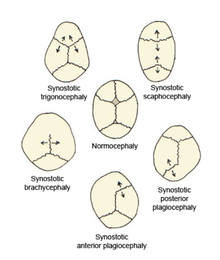Plagiocephaly
| Classification according to ICD-10 | |
|---|---|
| Q67.3 | Plagiocephaly |
| ICD-10 online (WHO version 2019) | |
A plagiocephaly is an asymmetric flattening of the back of the head. In contrast to brachycephaly , the ratio of length to width of the skull is not changed.
A congenital plagiocephaly may be caused by an unfavorable position in the womb; if it occurs due to premature unilateral suture closure, it is also known as craniosynostosis . It often is the Lambda seam or a coronal.
Prolonged lying of the babies on the back of the head can affect the shape of the skull and lead to plagiocephaly.
The brain is not affected by the shape of the skullcap . In connection with premature seam closure, face asymmetries can also occur.
Treatments
The supine position recommended by doctors for infants leads to a significant reduction in sudden infant death syndrome . However, this measure also favors a position-related head deformation. Usually, positioning cushions , side positioning rails or, in more pronounced forms, helmet therapy are recommended for treatment .
- Helmet therapy: In the case of a nonsynostotic cause, this method of therapy is common. Normally, a helmet is recommended to correct the deformity for a period of two months, which the baby to be treated should wear for 23 hours a day in order to achieve the best possible effect.
- Positioning pillow: If the skull is slightly deformed due to its position, it is often recommended to use a special baby pillow (perforated pillow) for sleeping while sleeping. These pillows have a head recess that stabilizes the baby's skull while sleeping in the supine position. The aim is to relieve an already flattened occiput. In the first few weeks of life, a special pillow like this can be helpful in addition to a classic alternating position using towel rolls. Often it is observed with this position that babies with a “chocolate side” turn their head to the affected flat area - the taking of a preferred position cannot be effectively prevented in this way. From a purely physical point of view, an already flattened occiput is not really relieved, the hollow in the pillow only increases the contact surface for the already flattened back of the baby's head. As a result, a progressive skull deformity (plagiocephalus and brachycephalus) is at best slowed down, but not corrected.
- Side positioning splint: In order to effectively correct head deformations even in babies in the first year of life or in more pronounced asymmetry, the prominent occipital side can be loaded and the flattened head side consistently relieved by means of a side positioning splint. The baby is stabilized in the side position while sleeping, which also prevents turning into the risky prone position.
See also
- Hyde-Forster-McCarthy-Berry syndrome (X-linked mental retardation - plagiocephaly)
- Dolichocephaly
literature
- OP Gautschi, B. Rilliet, K. Schaller, B. Jenny: Positional plagiocephalus in infancy: diagnosis and treatment In: Praxis. Volume 102, Number 25, December 2013, pp. 1537-1542, ISSN 1661-8157 . doi: 10.1024 / 1661-8157 / a001506 . PMID 24326049 . (Review).
- K. Ebel, E. Willich, E. Richter (ed.): Differential diagnosis in pediatric radiology. Thieme 1995, ISBN 3-13-128101-4 .
- Moldings helmets for the treatment of children's skull deformities - testing the therapeutic benefit . Social medicine expert group “Aids and Medical Devices” SEG 5, September 2, 2005, MDK - MDS 2005.
Web links
- Plagiocephaly. In: Orphanet (Rare Disease Database).
- Plagiocephaly. In: Online Mendelian Inheritance in Man . (English)
Individual evidence
- ^ FC Sitzmann: Pediatrics. Diagnostics - therapy - prophylaxis. 6th edition, Hippocrates 1988, ISBN 3-7773-0827-7 .
- ↑ W. Schuster, D. Färber (Ed.): Children's radiology. Imaging diagnostics. Springer 1996, ISBN 3-540-60224-0 .
- ↑ Christy M. McKinney, Michael L. Cunningham, Victoria L. Holt, Brian Leroux, Jacqueline R. Starr: A case-control study of infant, maternal and perinatal characteristics associated with deformational plagiocephaly . In: Pediatric and Perinatal Epidemiology . tape 23 , no. 4 , July 1, 2009, ISSN 1365-3016 , p. 332-345 , doi : 10.1111 / j.1365-3016.2009.01038.x ( wiley.com [accessed January 9, 2017]).
- ↑ Plagiocephaly - smartpillow . In: smartpillow . October 3, 2016 ( smartpillow.de [accessed January 11, 2017]).
- ↑ Jan-Falco Wilbrand, Maximilian Seidl, Martina Wilbrand, Philipp Streckbein, Sebastian Böttger: A prospective randomized trial on preventative methods for positional head deformity: physiotherapy versus a positioning pillow . In: The Journal of Pediatrics . tape 162 , no. 6 , June 2013, ISSN 1097-6833 , p. 1216-1221, 1221.e1 , doi : 10.1016 / j.jpeds.2012.11.076 , PMID 23312680 .
- ↑ Plagiocephaly. In: Orphanet (Rare Disease Database).

